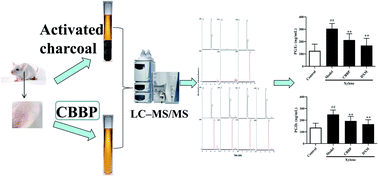Quantification of prostaglandins E2 and D2 using liquid chromatography-tandem mass spectrometry in a mouse ear edema model
Abstract
A sensitive, specific, and accurate high-performance liquid chromatography-tandem mass spectrometry (HPLC-MS/MS) method was developed and validated for the quantification of prostaglandins D2 (PGD2) and E2 (PGE2) in a mouse ear edema model. We used activated charcoal to obtain PG-free ear samples. The chromatographic separation was performed using a Hypersil Gold C18 column. The limit of detection of each PG was 0.4 ng mL−1, and the intra- and inter-assay estimates of precision and accuracy were <14.5 and 94.2–102.9%, respectively. Stability studies showed that all analytes were stable under various storage conditions and analytical processes. The developed and validated method was successfully used to investigate the anti-inflammatory effects of cultured bear bile powder (CBBP) by quantitatively determining PGE2 and PGD2 levels in mouse ear edema samples. These results showed that CBBP significantly inhibited the xylene-induced ear edema in mice and reversed the xylene-induced elevation of PGE2 and PGD2 levels. These results provide useful data about the anti-inflammatory bioactivities in tissues, mediated by the reduction of PGE2 and PGD2 levels, and may further encourage research and development studies of CBBP for its use as an anti-inflammatory agent.



 Please wait while we load your content...
Please wait while we load your content...